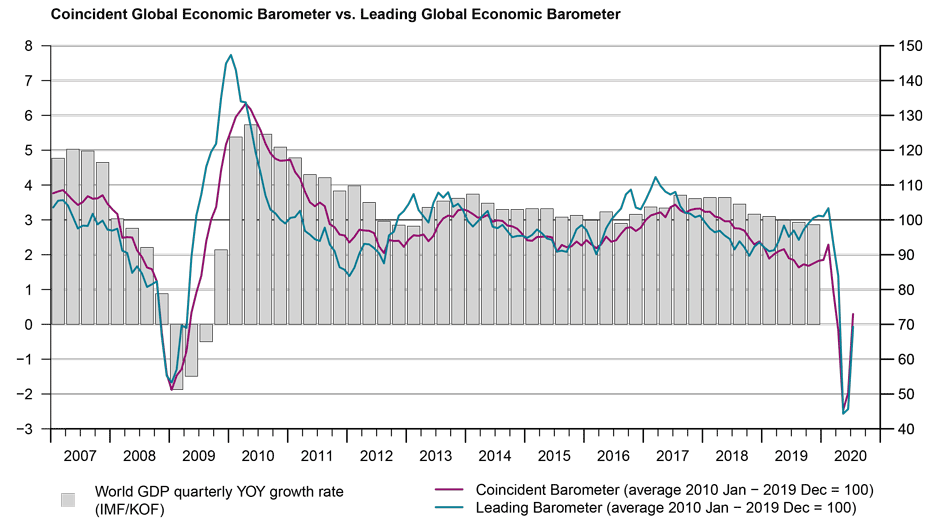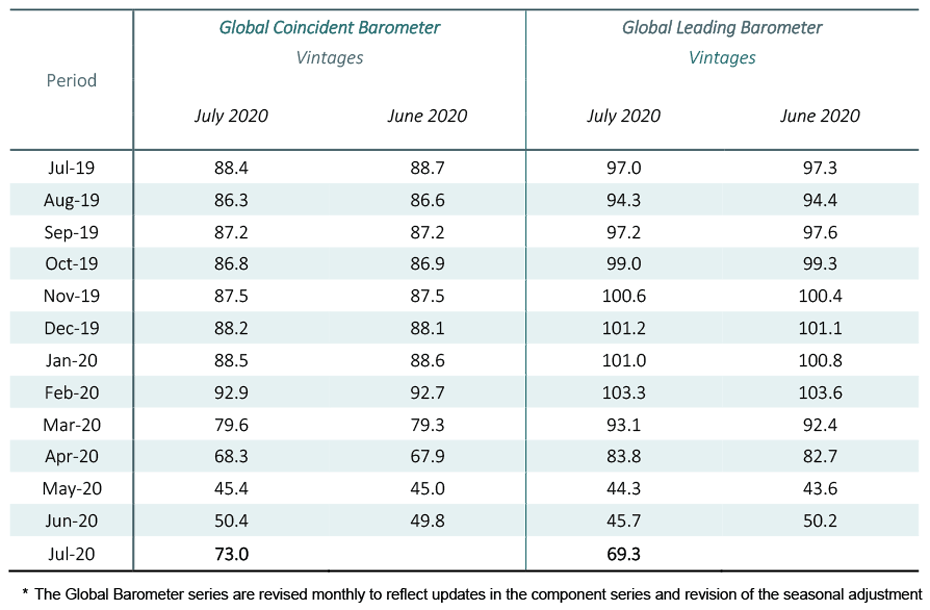Global Economic Barometers Signal Economic Rebound
The Coincident and Leading Global Economic Barometers have risen for the second consecutive month in July, indicating a gradual recovery of the world economy. Although the numbers have begun moving away from the trough of the crisis, further developments remain uncertain, both on the economic and the health front.
The Coincident Global Barometer has risen 22.6 points in July in comparison with the previous month, increasing from 50.4 to 73.0 points. Similarly, the Leading Global Barometer has gained 23.7 points, climbing from 45.7 to 69.3. Both indicators have advanced in line with the improvement in the economic environment in the three regions investigated. However, they are still 27 and more than 30 points below their long-term averages, respectively (i.e. about 3 standard deviations). The Asia, Pacific and Africa region exerted the greatest influence on the development of the Coincident indicator, while the Western Hemisphere was most influential on the development of the Leading Barometer.
“Although the recovery of the Barometers can be observed across all sectors and regions, the improvement should be interpreted with caution. The indicators have not yet reached their long-term average values and there is great uncertainty about the future development. Even though the gradual lifting of the lockdown measures has had a positive effect in many countries, the danger of a second Coronavirus wave remains – with potentially serious economic consequences,” says KOF director Jan-Egbert Sturm.
Coincident Barometer – regions and sectors
After the second consecutive rise, in the two months of June and July, the Coincident Barometer has recovered 58% of the losses accrued from March to May. The lion’s share of this month's 22.6 points increase came from the Asia, Pacific and Africa region (12.9 points). The second largest contribution of 7.1 points stemmed from the Western Hemisphere (North America, Latin America and the Caribbean). Europe contributed 2.6 points to the increase. The graph below illustrates the contribution of each region to the deviation of the Coincident Barometer from the historical mean level of 100 points.
Regarding sectors, for the first month since the beginning of the pandemic, there has been a positive evolution in every sector. The highest contributions to the increase in the Coincident Global Barometer once again came from Industry, followed by the set of variables reflecting the aggregated evolution of economies (Overall Economic Development). Services, Trade, and Construction have contributed moderately to the development.
Leading Barometer – regions and sectors
The Leading Global Barometer leads the world economic growth rate cycle by three to six months on average. All regions contribute to the rise of the indicator in July, with the Western Hemisphere being responsible for almost 60% of the month's evolution. Increased optimism regarding economic recovery led the region to contribute 14.0 points to the 23.7 points rise in the Leading Barometer in July. Europe contributed 8.9 points, while the Asia, Pacific and Africa region added only 0.8 of a point to the global indicator, possibly reflecting concerns about a potential second wave of Covid-19 diseases.
All sector indicators contribute positively to the result, with the variables connected to Overall Economic Development exerting the greatest influence on the Leading Barometer. Industry had the second largest influence, while the contribution of the remaining sectors was less relevant to the increase in the general indicator.
The full press release with table and graphs can be found Download here (PDF, 528 KB).
More information on the Global Economic Barometers can be found here.
The Global Economic Barometers
The Global Economic Barometers are a system of indicators that enables a timely analysis of global economic development. They represent a collaboration between the KOF Swiss Economic Institute of the ETH Zurich in Switzerland and Fundação Getulio Vargas (FGV) based in Rio de Janeiro, Brazil. The system consists of two composite indicators: a Coincident Barometer and a Leading Barometer. The Coincident Barometer reflects the current state of economic activity. The Leading Barometer, on the other hand, gives a cyclical signal that is roughly six months ahead of actual economic developments.
The two Barometers comprise the results of economic tendency surveys conducted in more than 50 countries. The aim is to achieve the broadest possible global coverage. Advantages of economic tendency surveys are that their results are usually available quickly and they are not substantially revised after the first publication.
The Coincident Barometer includes more than 1,000 different time series, while the Leading Barometer comprises over 600 time series. Cross-correlation analysis is used to decide which individual time series are included in the barometers. This involves correlating the individual time series with a reference series. The reference series used is the year-on-year growth rate of global gross domestic product (GDP), where the individual national GDPs are aggregated at purchasing power parity to form global GDP. A time series is only included in a Barometer if it shows a sufficiently high correlation and a suitable synchronisation or lead with the reference series.
The two Barometers are calculated once every month. They are usually published at the 10th of each calendar month. They are therefore available at a monthly frequency and in a timely manner.

